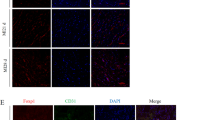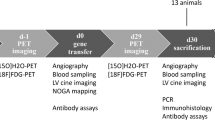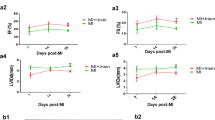Abstract
Angiogenic growth factors, vascular endothelial growth factor (VEGF) and angiopoietin-1 (Ang1) could decrease myocardial infarct size, which was assumed to be related with newly formed capillaries. We doubted that these capillaries could do this solely and the potential protective mechanisms of VEGF and Ang1 on myocardium need to be evaluated. Three types of adenoviruses encoding human VEGF165 (Ad-VEGF165), human angiopoietin-1 (Ad-Ang1) and green fluorescent protein (Ad-GFP, as a parallel control) were constructed. Experiments were taken both in vitro and in vivo. As in vitro, the antiapoptosis effect of VEGF165, Ang1 and VEGF165+Ang1 on cardiac myoblasts was observed, which seemed to be related with the activation of phosphatidylinositol-3 kinase and Bcl-2 pathways. As in vivo, adenoviruses were intramyocardially injected immediately after the ligation of the left anterior descending coronay arteries in rats. The results showed positive effect of VEGF165, Ang1 and VEGF165+Ang1 on decreasing the myocardial infarct size at the 7th day. Myocardial PI-3K activity and Bcl-2 expression were elevated relatively at the 3rd day. The protective effect of VEGF165 and Ang1 on the myocardium may broaden their functional research and contribute to their clinical use in the future.
This is a preview of subscription content, access via your institution
Access options
Subscribe to this journal
Receive 12 print issues and online access
$259.00 per year
only $21.58 per issue
Buy this article
- Purchase on Springer Link
- Instant access to full article PDF
Prices may be subject to local taxes which are calculated during checkout








Similar content being viewed by others
References
Shyu KG et al. Intramyocardial injection of naked DNA encoding HIF-1α/VP16 hybrid to enhance angiogenesis in an acute myocardial infarction model in the rat. Cardiovasc Res 2002; 54: 576–583.
Takahashi K et al. Adenoviral-delivered angiopoietin-1 reduces the infarction and attenuates the progression of cardiac dysfunction in the rat model of acute myocardial infarction. Mol Ther 2003; 8: 584–592.
Hershey JC et al. Vascular endothelial growth factor stimulates angiogenesis without improving collateral blood flow following hindlimb ischemia in rabbits. Heart Vessels 2003; 18: 142–149.
Partanen TA et al. Endothelial growth factor receptors in human fetal heart. Circulation 1999; 100: 583–586.
Ray PS et al. Effects of hypoxia/reoxygenation on angiogenic factors and their tyrosine kinase receptors in the rat myocardium. Antioxid Redox Signal 2001; 3: 89–102.
Matsui T et al. Akt activation preserves cardiac function and prevents injury after transient cardiac ischemia in vivo. Circulation 2001; 104: 330–335.
Gerber HP et al. Vascular endothelial growth factor regulates endothelial cell survival through the phosphatidylinositol 3-kinase/Akt signal transduction pathway. Requirement for Flk-1/KDR activation. J Biol Chem 1998; 273: 30336–30343.
Maulik N et al. Ischemic preconditioning reduces apoptosis by upregulating anti-death gene Bcl-2. Circulation 1999; 100: II369–II375.
Suhara T, Mano T, Oliveira BE, Walsh K . Phosphatidylinositol 3-kinase/Akt signaling controls endothelial cell sensitivity to Fas-mediated apoptosis via regulation of FLICE-inhibitory protein (FLIP). Circ Res 2001; 89: 13–19.
Krasilnikov MA . Phosphatidylinositol-3 kinase dependent pathways: the role in control of cell growth, survival, and malignant transformation. Biochemistry (Moscow) 2000; 65: 59–67.
Carlson TR et al. Direct cell adhesion to the angiopoietins mediated by integrins. J Biol Chem 2001; 276: 26516–26525.
Hutchings H, Ortega N, Plouet J . Extracellular matrix-bound vascular endothelial growth factor promotes endothelial cell adhesion, migration, and survival through integrin ligation. FASEB J 2003; 17: 1520–1522.
Maitra N, Flink IL, Bahl JJ, Morkin E . Expression of alpha and beta integrins during terminal differentiation of cardiomyocytes. Cardiovasc Res 2000; 47: 715–725.
Hanks SK, Ryzhova L, Shin NY, Brabek J . Focal adhesion kinase signaling activities and their implications in the control of cell survival and motility. Front Biosci 2003; 8: d982–d996.
Cary LA, Guan JL . Focal adhesion kinase in integrin-mediated signaling. Front Biosci 1999; 4: D102–D113.
Chen HC, Appeddu PA, Isoda H, Guan JL . Phosphorylation of tyrosine 397 in focal adhesion kinase is required for binding phosphatidylinositol 3-kinase. J Biol Chem 1996; 271: 26329–26334.
Pugazhenthi S et al. Akt/protein kinase B up-regulates Bcl-2 expression through cAMP-response element-binding protein. J Biol Chem 2000; 275: 10761–10766.
Catz SD, Johnson JL . Transcriptional regulation of bcl-2 by nuclear factor kappa B and its significance in prostate cancer. Oncogene 2001; 20: 7342–7351.
Asahara T et al. VEGF contributes to postnatal neovascularization by mobilizing bone marrow-derived endothelial progenitor cells. EMBO J 1999; 18: 3964–3972.
Orlic D et al. Bone marrow cells regenerate infarcted myocardium. Nature 2001; 410: 701–705.
Voermans C et al. Adhesion molecules involved in transendothelial migration of human hematopoietic progenitor cells. Stem Cells 2000; 18: 435–443.
Beltrami AP et al. Evidence that human cardiac myocytes divide after myocardial infarction. N Engl J Med 2001; 344: 1750–1757.
Lei Z et al. Cloning and construction of adenovirus expressing human angiopoietin-1 or vascular endothelial growth factor. Chin J Rehabil 2003; 7: 434–436.
Ytrehus K et al. Rat and rabbit heart infarction: effects of anesthesia, perfusate, risk zone, and method of infarct sizing. Am J Physiol 1994; 267: H2383–H2390.
Hu ZW, Shi XY, Lin RZ, Hoffman BB . α1-adrenergic receptors activate phosphatidylinositol 3-kinase in human vascular smooth muscle cells. J Biol Chem 1996; 271: 8977–8982.
Acknowledgements
We thank Drs Williams and Race Kao at Department of Surgery, James H Quillen College of Medicine, ETSU for their kindly advice and support. We also thank the teachers and students of the Institute of Molecular Medicine in Nanjing University for their kindly help in the daily work.
Author information
Authors and Affiliations
Rights and permissions
About this article
Cite this article
Zhou, L., Ma, W., Yang, Z. et al. VEGF165 and angiopoietin-1 decreased myocardium infarct size through phosphatidylinositol-3 kinase and Bcl-2 pathways. Gene Ther 12, 196–202 (2005). https://doi.org/10.1038/sj.gt.3302416
Received:
Revised:
Accepted:
Published:
Issue Date:
DOI: https://doi.org/10.1038/sj.gt.3302416
Keywords
This article is cited by
-
PTEN inhibitor improves vascular remodeling and cardiac function after myocardial infarction through PI3k/Akt/VEGF signaling pathway
Molecular Medicine (2020)
-
Co-cultured the MSCs and cardiomyocytes can promote the growth of cardiomyocytes
Cytotechnology (2018)
-
Angiopoietin-1 and Angiopoietin-2 in metabolic disorders: therapeutic strategies to restore the highs and lows of angiogenesis in diabetes
Journal of Endocrinological Investigation (2016)
-
IGF-1 gene-modified muscle-derived stem cells are resistant to oxidative stress via enhanced activation of IGF-1R/PI3K/AKT signaling and secretion of VEGF
Molecular and Cellular Biochemistry (2014)
-
Metabolomic profiles of myocardial ischemia under treatment with salvianolic acid B
Chinese Medicine (2012)



